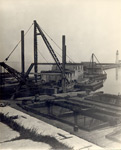Recalling the the Great Oswego Fleet
- Publication
- Oswego Palladium-Times (Oswego, NY), 1 Mar 1895
- Full Text
The office of John S. Parsons in the rear of his ship chandlery store has long ben a popular resort for lake captains and old sailors who Winter here, but with each year the attendance grows smaller.
There are two causes for this. One is that the sailing vessel is gradually going out of existence and the other is that many Oswego captains have been called West to take command of the new class of steamers that ply the upper lakes. But the office is an interesting place still and almost any day one can hear exciting old tar's twisters spun out there.
The writer dropped in at the "college," it is called, the other day and had a pleasant chat with one of the captains of Oswego's old-time fleet. We stood looking out of the window onto the harbor when he exclaimed:
"I tell you, the old harbor don't look much now as it did away back in the 'fifties' and the 'sixties' when Oswego's commercial trade was on the boom. Why, in those days the harbor used to be filled with vessels and all winter long from daylight until dark you could hear the pleasant sound of the caulker's mallet all through the fleet.
"The vessels were small, to be sure, and it took a good many of them to carry what that big black barge will, which you see over there, but a captain used to put on more airs than and was made more of, than the master of the finest ship that floats on the lakes now-a-days.
"The general appearance of the harbor has completely changed since I first sailed into port, here. There was but one tug here in those days. She was called the 'O.S. Howard' and had six-wheels. She needed to go to her berth at six o'clock every night and a vessel that came along in the night had to get into port as best she could.
"Henry Ames owned a floating elevator that use to propel herself about the harbor and the Government maintained a dredge that had an elevator on each side and she used to go about digging out the bottom of the harbor. Her commander was the late Captain Malcolm. She was bought by Littlejohn & Company, converted into a floating elevator for elevating grain and was afterwards taken to New York.
"Another old queer old craft which we had here in those days was a horse-power boat. The horses worked a circular tread-mill on deck and this operated the big side-wheels. This boat used to haul wood from Sterling Creek and Fair Haven to Oswego. The first stern wheel tug built here was launched just above the lower bridge by Peter Wright. She was called the 'Schuyler.' The next was the 'Nate Robbins,' built by Thomas Dobbie and captained by 'Bill' Manwarren. In those times the captain of a tug never yoused to touch the wheel. He handled the boat from the deck and bells ran to the engine room from both forward and aft. There was a regular wheelman and the captain could go to any part of the boat, Captain Van Alstyne took the 'Robbins' to Toledo.
"I tell you, things were lively around here in those old day. There was a great fleet of Oswego vessels on the lake, nearly all of which have since found resting places beneath he waves. The Oswego vessels were managed in lines then and each line had a name and a flag. The Diamond Line, for instance, was owned by Fitzhugh & Littlejohn. They carried a blue flag with a white diamond.
"The Black Ball line was owned by Penfield, Lyon & Company and their flag was white with a black ball in the center. Henry Ames' line had the same flag. The Red Ball Line was owned by Lewis & Beardsley. Their flag was white , with a red ball in the center. Latham & Tozer's line had a black ball with the letters L.& T. William Lewis's line carried a flag with a sheaf of wheat. Morgan Wheeler's vessels had a white flag with a bull on it.
"This is how they came to adopt the flag. Captain John Parsons was in command of the vessels "Euphrates" in 1861. She carried livestock on the upper lakes and flew at the masthead a flag with the picture of a bull. The schooner was lost on Sandusky bar and Captain Parsons gave the flag to Captain Sweet, who was on his way to Oswego with one of Wheeler's vessels. The vessel came into port on Sunday and was moored near the bridge. The flag was flying in a stiff breeze and being a large one, attracted great attention from people passing on the bridge.
"Morgan Wheeler was pleased with it and adopted it for his line. The flags of Thomas S. Mott's vessels were red and white with the letter "M" in the center. Lyon's and Finney's flags were red with the letters "L" and "F."
- Media Type
- Text
- Newspaper
- Item Type
- Clippings
- Notes
- Article signed at the bottom 'S.J."
- Date of Publication
- 1 Mar 1895
- Subject(s)
- Collection
- Richard Palmer Collection
- Language of Item
- English
- Geographic Coverage
-
-
New York, United States
Latitude: 43.4581603192855 Longitude: -76.5109884738922
-
- Creative Commons licence
 [more details]
[more details]- Copyright Statement
- Public domain: Copyright has expired according to the applicable Canadian or American laws. No restrictions on use.
- Contact
- Maritime History of the Great LakesEmail:walter@maritimehistoryofthegreatlakes.ca
Website:


